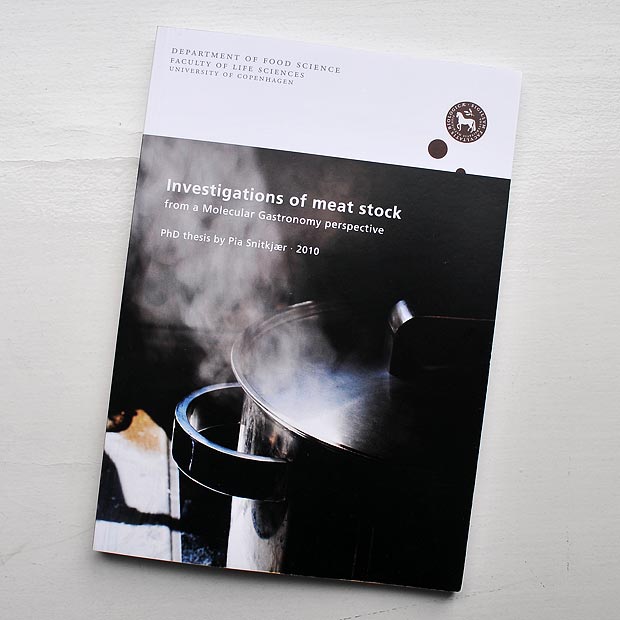Pia Snitkjær’s thesis on Investigations of meat stock from a molecular gastronomy perspective can be downloaded free of charge. Part I includes an excellent introduction to molecular gastronomy, part II covers meat stocks with and without red wine.
Pia Snitkjær was the first student in the molecular gastronomy project at the University of Copenhagen to complete her studies. She defended her PhD thesis on Investigations of meat stock from a molecular gastronomy perspective in December last year, and this was also the topic of her presentation at the recent seminar on molecular gastronomy at the University of Copenhagen. Meat stock is typically prepared by boiling meat, bones, vegetables, spices and herbs, and after straining the remaining liquid it is reduced in volume by further boiling. The central question in the thesis was how the reduction affects the flavor and texture of the stock. Cookbooks only specify the concentration factor, but not the time needed to achieve this reduction.
If you’re only interested in the conclusion from a gastronomic perspective the take home message was that the reduction time has a significant impact on flavor. For more flavor you want to do a slow reduction over low heat (see illustration below). But you should not overdo it as this will result in bitter and burned flavors. A reduction time of 15-20 hours seems to be optimal. The simple explanation is that with a high power input volatiles evaporate from your stock pot before they have time to react to generate new flavors (for instance in Maillard type reactions).

Figure from Pia Snitkjær’s thesis showing the effect of the reduction time on the aroma concentration of the resulting stock (Copyright Pia Snitkjær, used with permission)
Pia’s thesis (free download, 0.7 Mb) has two parts. The first is an introduction to molecular gastronomy, and frankly this is the best introduction that I’ve read to date on molecular gastronomy! The second part covers preparation of meat stocks with and without red wine.
Pia did two sets of experiments to arrive at these conclusions. In the time experiment she prepared stocks with concentration factors (CF) ranging from 2-12 as a function of the reduction time (3-36 h). Studying the volatiles she found that they fell into three categories:
- Decrease: 2-pentanone and 2-propanone (boiling points: 101-105 °C, 57 °C)
- Increase up to 15-20 h followed by decrease: 1- butanol and nonanal (boiling points: 118 °C, 195 °C)
- Increase: acetic acid and 3-methyl butanal (boiling points: 118 °C, 91-93 °C)
The boiling points illustrate that category 1 is driven off fast due to lower boiling points whereas category 2 will evaporate very slowly (and possibly only be removed through an aerosol). The last category has lower boiling points suggesting that these compounds were not present from the beginning and are only formed after an extensive reduction.
Similarily she observed the following flavor changes of the same time span:
- Decrease: boiled meat, nutty, sweet flavor
- Increase up to 15-20 h followed by decrease: tar, roast crust
- Increase: bitter, burned, sour, astringent
In the power experiment she studied the effect different power inputs (corresponding to reduction time of 4-30 h) have on a stock reduced to the same concentration factor. The resulting flavor profiles were very different with a key result being that a high power input results in a rapid loss of volatiles. A slower reduction leaves more time for new flavors to develop. Further details can be found in the thesis and in the paper Flavour development during beef stock reduction [1].
Pia Snitkjær presenting her results at the recent MG seminar in Copenhagen
There was no time to go into details of her second research paper on red wine in stocks, but the results have been published: Beef stock reduction with red wine – Effects of preparation method and wine characteristics [2]. An important finding was that wine and stock should be reduced together, not separately – this diminished the astringency from the tannins, most likely due to precipitation of insoluble protein-tannin complexes (just like the ones which make Norwegian egg coffee easy to drink). Furthermore it was shown that the initial differences in the aroma profile of the wines was partly eliminated by boiling. The choice of wine however still had an impact on the resulting flavor because the non-volatiles such as sugars, acids and phenolics of a wine did influence the end result. More specifically a reduced stock made with Zinfandel had bread, herb, wine-vinegar and chicken notes whereas a reduced stock made from Cabernet Sauvignon was dominated by beef and onion odors accompanied by a “salt taste and a significantly higher intensity of particulate mouthfeel and bitter taste”.
[1] Snitkjær, P.; Frøst, M. B.; Skibsted, L. H.; Risbo, J. Food Chemistry 2010, 645. DOI: 10.1016/j.foodchem.2010.03.025
[2] Snitkjær, P.; Risbo; J.; Skibsted, L. H.; Ebeler, S.; Heymann, H.; Harmon, K.; Frøst, M. B. Food Chemistry 2011, 183. DOI: 10.1016/j.foodchem.2010.10.096



Hi, sounds very interesting, but I can’t get the links to Pia’s thesis to work out?
Edmond: The pdf is linked directely, so make sure you haven’t blocked pop-up windows. But if it for some reason doesn’t work, try this link: http://rex.kb.dk/primo_library/libweb/action/display.do?fn=display&vid=KGL&afterPDS=true&doc=dedupmrg225661247
These results (although probably not very surprising) have their direct parallel to cooking/production of Norwegian brown “cheese” called brunost. This is produced by boiling in whey until brown and most water has evaporated. Lots of maillard and caramelization products.
Parallel to paper no. 1:
cooking large baches results in much darker and stronger-flavoured product compared to small batches, which turn out lighter and milder. Furthermore, brown cheeses from different regions in Norway traditionally have different colour and flavour partly due to batch size. Areas with historically large farms with many animals gave large batches and hence darker product (typically eastern inland Norway, Gudbrandsdalen), whereas parts of the country characterized by small farms with just a very few animals would traditionally have lighter and milder varieties (typically western along the coast).
Parallel to paper no. 2:
different sorts of milk have been used; cow milk or goat milk, or a mix. Different sorts of milk would obviously give different product
[…] Han har som regel en masse nyttige lenker i innleggene og for noen dager siden ble det som skulle vært litt blogg-surfing fort til en 4-timers leseøkt om kjøttkraft! Det er den danske doktorgradsstipendianten Pia Snitkjær Nielsen som har skrevet avhandlingen “Investigation of meat stock from a molecular gastronomy perspective” og du kan lese en god oppsummering av avhandlingen på Khymos-bloggen: Copenhagen MG-seminar: Meat stock. […]
Restaurant where I use to work , we made demi took us 5days, we never roasted the bones, lightly caramelized the onions near the end around day 3/4. and Reduced slowly.
Bones were brought to a boil and rinsed new water and made stock simmer never boil
I have tried the link and allowed pop ups but still can’t get pdf or file to print from. Could someone e-mail me the pdf file please
[…] Snitkjær: Investigations of meat stock from a molecular gastronomy perspective. (gesehen bei Khymos). Hitze hin, Kalbsfond musste […]